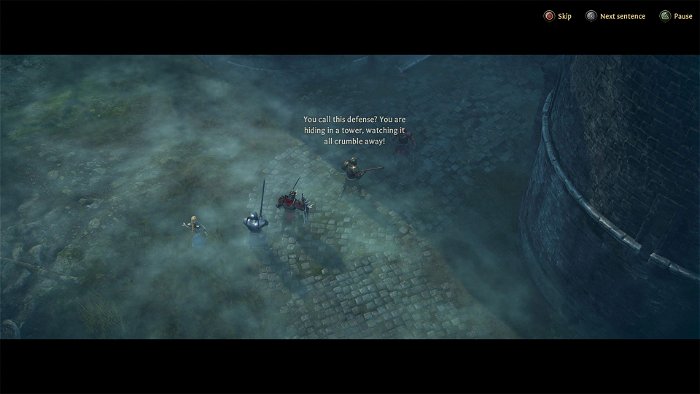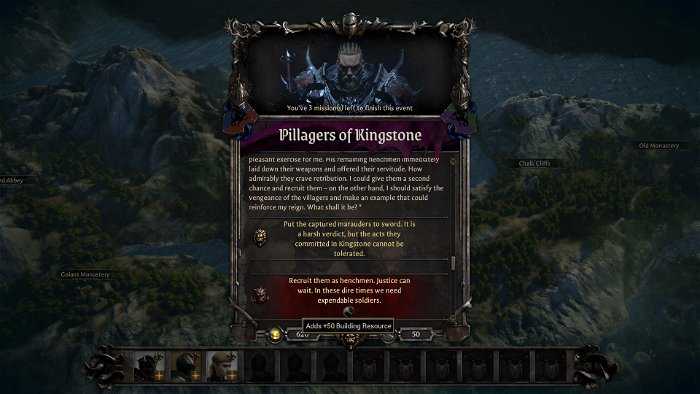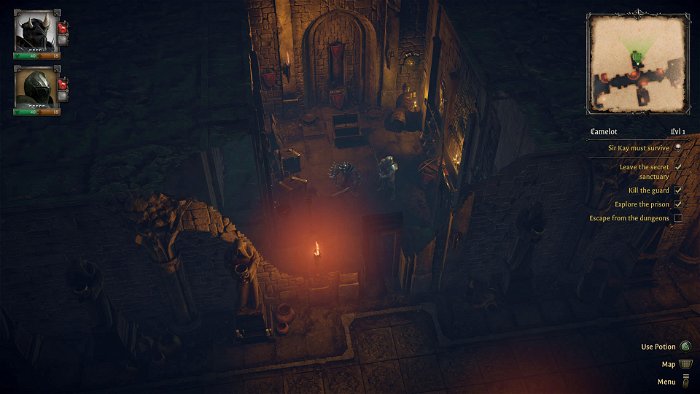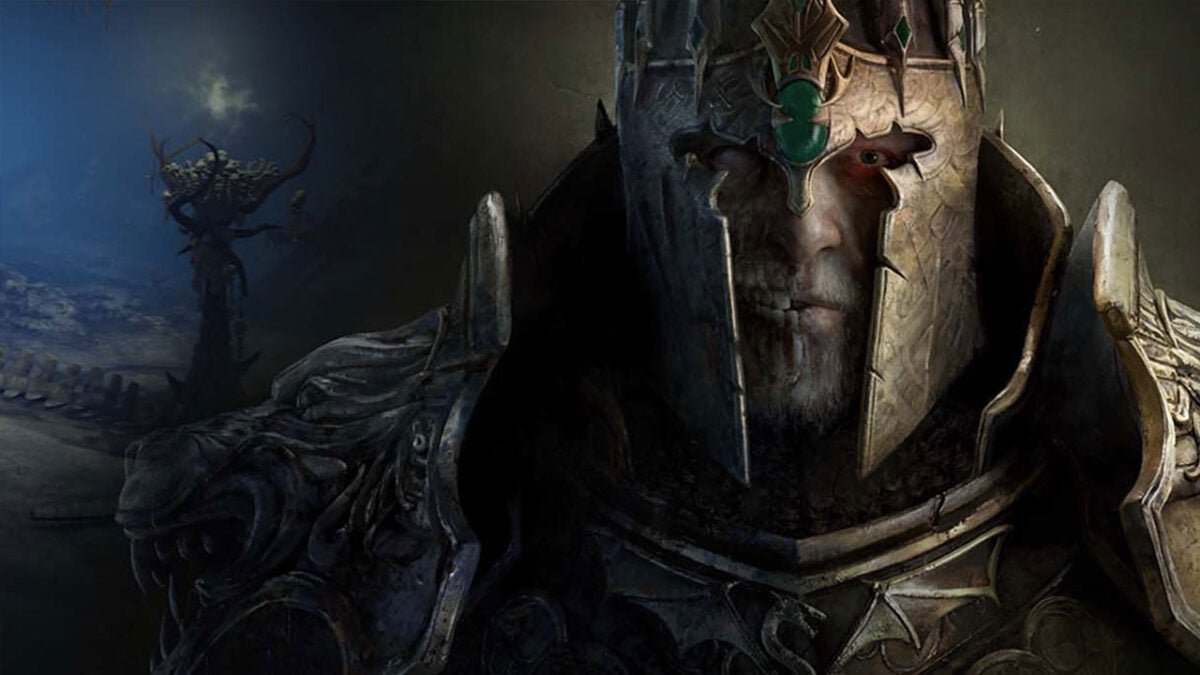I was actually pretty interested in King Arthur: Knight’s Tale when the review opportunity came across my desk. I had once been fairly involved in Arthurian legend—by which I mean I took a course on it during my first year of university—but it was always a fascinating subject. Part myth, part history there’s a lot you can do with the stories of the once and future King.
I’ve said in the past that reviewing mediocre games is way less fun than anything good or bad. When something is good, you can rave about it, and when something is bad, you can rip it apart. But mediocrity is both boring to experience and talk about and that was effectively my experience with King Arthur: Knight’s Tale—a perfectly okay game that neither excited nor infuriated me enough to really care.

I want to say this right off the top because I’ve had some confusion in the past with my reviews. I’m not saying King Arthur: Knight’s Tale is a bad game. It’s perfectly fine—relatively well-crafted, with a decent enough collection of gameplay ideas inspired by others and a reasonable amount of polish.
My issue with the game isn’t that it’s bad, it’s that it’s just boring. From its overall design to its gameplay, even its visuals all just kinda blend together in a grey/brown mush that never made me want to continue with it—struggling as I did to get through it for this review.
“King Arthur: Knight’s Tale has a fairly interesting story, flipping the narrative of the King Arthur mythos on its head and somewhat reinterpreting the last book of Le Morte d’Arthur…”
King Arthur: Knight’s Tale takes place after a great big war between King Arthur and the dread knight Sir Mordred—essentially covering the final chapter of Le Morte d’Arthur. During the battle, Mordred lands a killing blow on Arthur, but is, in turn, killed himself. However, a strange power has gripped the land. Sir Mordred rises from the grave only to be informed by the Lady of the Lake that King Arthur has been twisted from the noble ruler he once was and has poisoned the land with unknown horrors. It is now up to Sir Mordred to claim the throne of Camelot and destroy his former foe once and for all.
King Arthur: Knight’s Tale has a fairly interesting story, flipping the narrative of the King Arthur mythos on its head and somewhat reinterpreting the last book of Le Morte d’Arthur—setting the player in the role of one of Arthur’s central antagonists. However, the issue comes more from the telling of the story, which is incredibly dreary and not at all compelling. The problem stems mainly from Sir Mordred as a character who never feels fully realized as a character.

His design is somehow garish yet incredibly dull, as if someone typed “medieval demon knight” into Google and went with the first result. Despite being described as a terror and a scourge, Mordred is never really personified as particularly evil—just grumbly and annoyed. Every now and again, he may spout some flavour dialogue that suggests he’s a bad dude, but the game and the story never really go all the way with it, leaving him as a bit of a cypher.
Most other characters in the game are equally uninspired, with boring armour and character profiles. You may notice some of the familiar names from Arthurian legend, but in combat and in dialogue, they all repeat the same lines about honour and striking foes down in the name of God. If this game had gone all the way and cranked the camp up to 11, it could have been really fun. Instead, it just becomes a forgettable affair that at no point did I ever engage with.
The gameplay suffers in the same way. Again, it’s not bad by any means, but it’s just not very remarkable, especially when you can see all the inspirational sources it’s pulling from. It looks like Diablo, it plays like Fire Emblem, there’s a little bit of Darkest Dungeon in there if you’re paying attention.
Players will move Mordred and his knights around an area—from a top-down perspective—until they engage in combat encounters. These encounters take the form of turn-based strategy, but it’s the way the game tries to combine the Diablo-style RPG elements with Fire Emblem-style turn-based combat that filled my brain with a dense fog, making every battle a testament to staying awake.

Like I said, at its core, the combat is Fire Emblem. Players move their units and initiate attacks during their phase, and then the enemies will begin there. However, King Arthur: Knight’s Tale finds a way to make this needlessly tedious by giving characters skill points for each turn. These points are spent attacking, using special abilities or, worst of all, by MOVING.
Now, in theory, I get what the game was going for—you need to manage your moves effectively like Action Points in a tabletop RPG. But limiting your character’s actions by tying their use to the simple act of positioning your character near an enemy makes every battle a complete slog.
This is compounded by the fact that even a basic attack usually consumes four ability points, and most characters only have between seven and eight. And since most fights usually start you on the opposite end of your opponent, and you lose one point for every square of movement, just trying to close the distance will give your enemy an advantage. This is what I mean by the fights being boring—you end up having to waste whole turns just to get even close to the enemy, and it takes forever.

Furthermore, the combat adds unnecessary levels of complexity to the proceedings that I genuinely felt could have been streamlined in a much neater fashion. For starters, characters have three different types of health: Armour, Vitality, and Injury. Certain attacks can break armour, which will lead to characters losing Vitality points. Once they lose all their Vitality, they’ll start to lose Injury points, the loss of which carries over between missions. If a character loses all their Injury points, they will die forever.
In order to recover Injury points, characters will need to spend a mission in Camelot’s Hospice, which leads to the aforementioned Darkest Dungeon elements. Between missions, players can spend gold and resources to rebuild Camelot to its once and future glory. Structures such as a merchant’s tent, training ground and hospice can all be unlocked, providing benefits to the player so long as they are left for a mission or two to reap the benefits. It’s not particularly remarkable—there’s a system where you can set characters to act as figureheads for the various structures for different benefits—along with setting different knights to the Round Table for loyalty bonuses.
“King Arthur: Knight’s Tale isn’t bad by any means. It’s just boring.”
Oh yeah, loyalty is a thing that affects how characters do in combat, but not like how in Fire Emblem where characters get bonuses fighting beside each other or linked as a couple, instead it’s sort of like an…overall stat effect? Also, and maybe this just bothers me, but it’s kind of weird that characters don’t unlock skills in the traditional way they would by levelling up in an RPG. Instead, you need to leave them in the training ground during missions, further adding to the tedium of combat.
And there are just so many more uninspired elements that make the game more tedious than fun. The game was clearly designed for PC but now has to be mapped to a controller, which can result in some frustrating and tedious icon scrolling. There are separate buttons for moving your character and attacking enemies for some reason—I guess pressing X on a space to move and on an enemy to attack was too complicated.

There are dialogue trees, but they don’t really matter since every conversation leads to the same result no matter what you choose—I guess they add some minor details to the plot, but it’s usually just whether you want Mordred to sound like a jerk or mildly practical. There’s a moral choice system, but it didn’t really change the moment-to-moment gameplay.
Visually, as I said, it’s a grey/brown mess evocative of that terrible era of games during the 2010s when everything had to be gritty and “realistic.” This is a game about King Arthur and his cursed rival coming back from the dead to fight each other. Where’s the colour? Where are the interesting landscapes and fun? Instead, everything looks ripped from the most boring version of Diablo.
Furthermore, again like I said, all the characters and enemies are just generic-looking knights and the occasional generic zombie peasant or zombie knight. Even some of the more Fae-like enemies aren’t particularly memorable and almost all of the main characters have the most basic fantasy designs possible—they even made Merlin uninteresting. Merlin…you know, THE WIZARD!

The audio is equally uninspired, with a handful of your basic medieval-style fantasy tracks that cycle through missions. Like most of the game, they’re not particularly bad, but they’re not memorable, nor are they especially exciting. They lack the sense of tension you get from some of the similar bombastic tracks from Darkest Dungeon, and none of them give you the same sense of scale and desperation as Fire Emblem: Three Houses’ “Fodlan Winds.”
Like I said at the top of this review, King Arthur: Knight’s Tale isn’t bad by any means. It’s just boring. There’s a lot about it I don’t like, but I don’t think it’ll turn off any fans of RPGs or turn-based strategy games—especially considering this game came out in 2021 and already established a fanbase. If you’re really craving a turn-based strategy game on the PS5, this may scratch that itch, but honestly, I think there are better entries in the genre out there.





